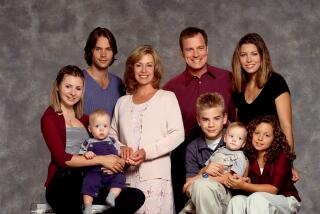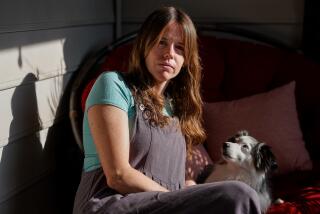Living With the Moppet Movie
Old movies are marinated in memory for anyone over the age of 3, and clips from the movies, whether they were good or bad in their time, have a piquancy that never loses its power to mist the eyes or tighten the throat.
So it is with “When We Were Young . . . Growing Up on the Silver Screen,” a 90-minute look at child stars from Jackie Coogan forward. It airs today on Channel 28 at 8:10 p.m.
Here again are Spanky McFarland and his “Our Gang” pals, Jackie Cooper crying for Wallace Beery in “The Champ,” Shirley Temple tap-dancing up the steps with Bill Robinson, Freddie Bartholomew fishing with Spencer Tracy in “Captains Courageous,” the pre-teen Elizabeth Taylor in “Lassie Come Home,” Roddy McDowall scrambling to reach Donald Crisp as his trapped and dying coal miner father in “How Green Was My Valley,” Mickey Rooney as Andy Hardy and being kids together with Judy Garland, 10-year-old Dean Stockwell preaching against war in “The Boy With Green Hair,” moppet Margaret O’Brien as a 5-year-old war orphan in “Journey for Margaret.”
And, as they say, much more.
There are interviews with several of the stars, including Dickie Moore, whom we’ve just watched, at 7, being consoled by Marlene Dietrich in “Blonde Venus,” and Diana Serra Carey of the greatly popular “Baby Peggy” series.
The excerpts demonstrate, or reaffirm, just how startlingly good some of these performers were. Shirley Temple was miraculously precocious, the winsome dimpled smile still mesmerizing to watch 60 years later, the feet seemingly able to tap anything. The emotional power of the young Bartholomew and the young McDowall would be impressive as acting at any age.
The sharp disappointment is that the narration (delivered by Maureen Stapleton, written by James Arntz, who co-produced with Shelley Spencer, and Katherine MacMillin) is superficial and sentimental to the point of fatuity.
With few exceptions the interviewees were not provoked to go beyond kind generalities. Jackie Cooper, who has painful memories of his child-star days, chats briefly about the trickeries used to make him cry on camera (a gunshot offstage that presumably killed his dog), but it is as if it hardly mattered. (In fact it took a psychologist two days to help Cooper stop crying.)
McDowall wryly remembers the realization at age 17 or so that the child-star days were over. He shifted gears and continues to work. Bartholomew and Claude Jarman Jr. (“The Yearling”) opted out. Neither was interviewed and it would have been interesting to hear them on the subject of their childhoods.
Hayley Mills remembers her Disney and “Parent Trap” days and then, in one of the show’s infrequent moments of real insight, muses that her childhood and her child stardom went on too long for her own good, because that was what the public wanted. She was from a theatrical family; it was the way things were, but it is an implicit glimpse of the child as a property.
Tommy Rettig of the television “Lassie” is candid if unspecific about the pain of readjusting to “normal” life after the original series ended.
There are sequences, now doubly affecting, of the 11-year-old Natalie Wood in “Miracle on 34th Street.” And the vibrant young Garland of “Meet Me in St. Louis” and “The Wizard of Oz” cannot be watched unemotionally.
There is no mention of Jodie Foster, who is without much question the ablest child star of recent years and who has proved it by going from strength to strength as she has matured.
The florid narration, suggesting that the child stars got us through the Depression and World War II single-handedly and taught us all we know about living, is the more frustrating because it too largely ignores the children as children.
Jane Withers tearfully confesses she wouldn’t have missed a minute of it and most of her contemporaries would no doubt, on balance, agree with her. Yet several of them spent years recovering from the childhoods they never really had.
Jackie Cooper has remembered (elsewhere) sitting on Louis B. Mayer’s lap as Mayer tearfully counseled that the fate of the whole studio was resting on Cooper’s shoulders. Cooper was about 5.
In my magazine days I had to arrange a photograph of Shirley Temple, then hosting “Shirley Temple’s Storybook” at NBC in Burbank, standing with a lifesize cutout of herself as (I think) the Little Colonel. She looked at her young image and said, “I don’t know this person at all; she’s a stranger to me.” It was a brief, intense but fleeting moment, a seeming commentary on spending your youngest years as a very hard-working public figure.
Shirley Temple Black wasn’t interviewed for the program; I wish she had consented to be, although she might have been politic about any of the dark memories of her days of glory and the later readjustment to semi-private life.
As it is, “When We Were Young” is like a very expensive Valentine, handsome to look at but with a cloying and unsatisfying message.
Dick Carter directed, Don DeMartini was the editor, and the selection and integration of the clips is the show’s great strength. It also will be seen Wednesday at 8 p.m. on Channel 15, Friday at 8:30 p.m. on Channel 24 and Dec. 9 at 8 p.m. on Channel 50.
More to Read
Only good movies
Get the Indie Focus newsletter, Mark Olsen's weekly guide to the world of cinema.
You may occasionally receive promotional content from the Los Angeles Times.










